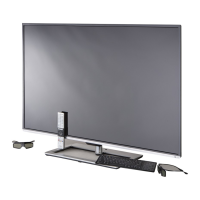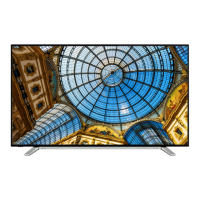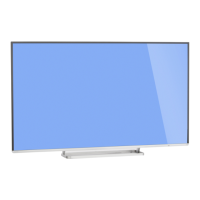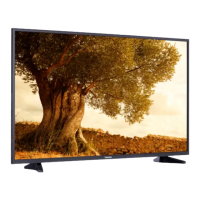How to remove black box on Toshiba 58L7300U screen?
- CCarrie PhamSep 8, 2025
To remove a black box on your Toshiba LED TV screen, set the closed caption feature to Off.

How to remove black box on Toshiba 58L7300U screen?
To remove a black box on your Toshiba LED TV screen, set the closed caption feature to Off.
How to resolve HDMI™ CEC operation issues on Toshiba LED TV?
To resolve HDMI™ CEC operation issues on your Toshiba LED TV, turn off the TV and unplug the power cord. After about a minute, plug the power cord back in and turn on the TV. You can also try using a different HDMI™ cable.
Why can't I view external signals on my Toshiba 58L7300U LED TV?
To view external signals on your Toshiba LED TV, ensure that the Input Lock is set to Off.
How to improve poor composite picture on Toshiba LED TV?
To improve a poor composite picture on your Toshiba LED TV, try using a ColorStream or HDMI™ video connection instead.
| Display diagonal | 58 \ |
|---|---|
| LED backlighting type | - |
| Supported video modes | 1080p |
| Display diagonal (metric) | 147.3 cm |
| Screen format adjustments | 16:9 |
| Supported graphics resolutions | 1920 x 1080 (HD 1080) |
| 3D | No |
| Audio system | Audyssey |
| HDMI ports quantity | 4 |
| DVI-D ports quantity | 0 |
| USB 2.0 ports quantity | 2 |
| Compatible memory cards | Not supported |
| Component video (YPbPr/YCbCr) in | 1 |
| Smart modes | Dynamic, Game |
| Lifestyle apps | Skype |
| Product color | Black |
| Panel mounting interface | 400 x 400 mm |
| Power consumption (standby) | - W |
| Sustainability certificates | ENERGY STAR |
| Package depth | 160 mm |
| Package width | 1430 mm |
| Package height | 907 mm |
| Depth (with stand) | 333 mm |
|---|---|
| Height (with stand) | 851 mm |
| Weight (with stand) | 27700 g |
| Depth (without stand) | 58 mm |
| Width (without stand) | 1306 mm |
| Height (without stand) | 765 mm |
| Weight (without stand) | 25000 g |
Explains the meaning of safety icons used in the manual for hazard identification.
Lists and describes the key features of the Toshiba LED TV, including connectivity and display technologies.
Provides a step-by-step guide to initial TV setup, location selection, and basic usage.
Details various audio and video cable types and their connections for different devices.
Guides on connecting broadcast sources like antennas and cable boxes to the TV.
Instructions for connecting high-definition sources like computers and media players via HDMI or DVI.
Explains how to connect the TV to a home network for internet access and media sharing.
Step-by-step instructions for inserting batteries into the TV remote control.
Overview of the remote control buttons and their functions for operating the TV.
Guides the user through the first-time TV setup process, including language and basic settings.
Explains how to access and navigate through the TV's on-screen menu system.
Details how to modify basic TV settings such as language, country, and time zone.
Instructions on how to automatically or manually tune and store TV channels for easy access.
Guides on how to skip unwanted channels or video inputs for a streamlined viewing experience.
Covers tuning to channels, including next programmed, specific, and using channel return.
Explains how to switch between different video sources connected to the TV.
Details how to turn on and customize closed caption display for analog and digital channels.
Guides on setting a PIN code, managing parental controls, and blocking programs by rating.
Explains different picture size options and how to select them for optimal viewing.
Provides guidance on adjusting picture settings like brightness, contrast, color, and sharpness.
Details features like Edge Enhancer, Dynamic Contrast, and noise reduction for picture refinement.
Covers audio settings including muting, balance, range, speakers, and primary audio language.
Explains how to connect the TV to a home network for sharing media and accessing internet services.
Comprehensive guide to configuring wired and wireless network connections, including security settings.
Introduces Toshiba's portal for internet content, services, and apps available on the TV.
Explains how to use TV companion apps on mobile devices for enhanced functionality.
Guides on managing registered devices, enabling new device detection, and pairing with mobile devices.
Provides initial steps and common solutions for general TV issues before seeking service.
Addresses common issues related to display quality, input selection, and signal reception.
Offers solutions for audio issues such as no sound, poor audio quality, or out-of-sync audio.
Covers troubleshooting for internet connectivity, network setup failures, and unstable connections.
Details the TV's supported television systems and frequency ranges for broadcast reception.
Provides technical data on the TV's power requirements and energy usage.
Lists and describes the various video and audio input/output ports available on the TV.
Outlines the technical specifications for the TV's wireless, Ethernet, and USB connectivity.
Specifies the compatible signal formats for PC IN and HDMI™ inputs for optimal display.
Instructions for configuring the wireless keyboard layout for special character input.












